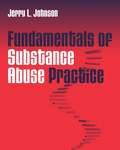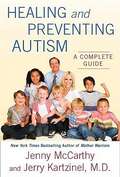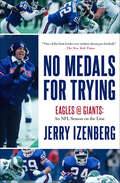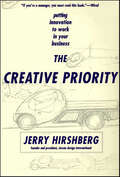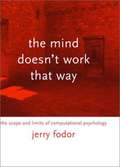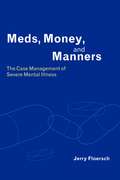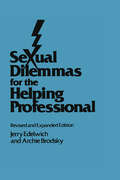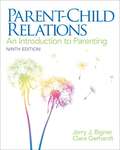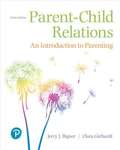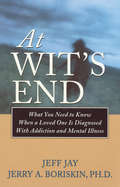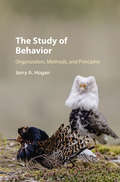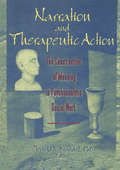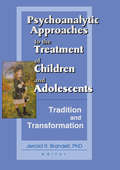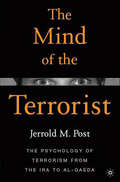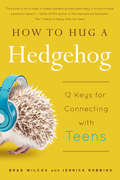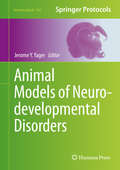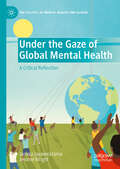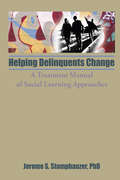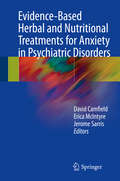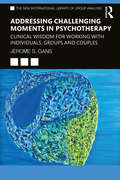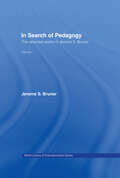- Table View
- List View
Fundamentals of Substance Abuse Practice
by Jerry L. JohnsonProviding a text for undergraduate and entry-level graduate students in social work, and a resource for practitioners, Johnson shows how to gather and use multi-systemic and multi-level client data for assessing and treating substance abuse in individuals and families. Johnson, a practitioner with more than 20 years in substance abuse practice, begins with an overview of the field including prevalence of substance abuse problems and definitions of use, abuse and addiction. Additional chapters describe the effects of specific drugs, prominent theories and models for practice, methods for client engagement and communication, the influence of the community on individuals and families seeking substance abuse services, and strategies for multi-systemic treatment planning. Annotation (c)2003 Book News, Inc., Portland, OR (booknews.com)
Healing and Preventing Autism
by Jenny Mccarthy Jerry KartzinelJenny McCarthy-whose bestselling books Louder Than Words and Mother Warriors told the stories of healing children with autism-teams up with a preeminent autism doctor to write the first book on a remarkably effective treatment. In 2006, autism became the leading disorder affecting children in the United States. While diagnoses skyrocket and parents struggle to find help, a group of innovative doctors has been pioneering therapies and treatments that are remarkably effective in healing conditions associated with autism. As word spreads about these incredible discoveries- helped in part by Jenny McCarthy's book Louder Than Words- parents are desperate to learn about the biomedical therapies for themselves. Since early intervention is key to a successful recovery, McCarthy has teamed up with Dr. Jerry Kartzinel, the doctor who successfully treated her son, to write the first book to give parents all the necessary information about biomedical treatment. Beginning with diagnosis, Dr. Kartzinel explains the different therapies that he uses. He shows parents how to make simple changes to their child's environment and diet that can result in marked improvements and are safe and easy to try at home. And finally he explains some of the more advanced therapies that many doctors use today, and the way parents, alongside a qualified medical professional, can determine whether or not such treatments would benefit their child. For new parents, Dr. Kartzinel provides helpful guidelines on how to best protect their child from developing autism.
"No Medals for Trying": Eagles @ Giants: An NFL Season on the Line
by Jerry IzenbergThe legendary sportswriter &“details the grit of the gladiators and the psyche of the coaches . . . One of the best books ever written about pro football&” (The New York Times). Monday, November 27, 1989. After a ten-point loss to the San Francisco 49ers, the New York Giants return home. Thirty-four-year-old quarterback Phil Simms has reinjured his ankle. Linebacker Lawrence Taylor, the guts of the defense, is in great pain, supported by crutches. And while the players, coaches, and trainers are still lost in thoughts of what might have been, the next game looms large in front of them: a now must-win battle against their division rivals, the Philadelphia Eagles. What follows is an intense, hour-by-hour account of a team pushed to the brink. Sportswriter Jerry Izenberg, granted unprecedented access, chronicles the tremendous physical and emotional strain experienced by both those on the frontlines and behind-the-scenes—the embattled superstars, workhorses, defensive and offensive staffs, and equipment managers. Izenberg shadows head coach Bill Parcells as he struggles to rally his team and draw up a game plan without his clutch players. He puts readers in the maelstrom of stress, uncertainty, and grim determination that permeate the locker room as the players face a team that has beaten them three time in a row—in a game that will decide the division. It&’s all here as &“Izenberg builds the suspense so masterfully that grid aficionados will be caught up in the story&” (Publishers Weekly). &“Izenberg&’s hour-by-hour account of the painstaking preparations will open the eyes of even the most knowledgeable fan.&” —The Buffalo News &“The book is a treat for football fans.&” —The Baltimore Sun
The Creative Priority: Putting Innovation to Work in Your Business
by Jerry HirshbergHow does your company define creativity? Or doescreativity define your company? In this remarkable book, Jerry Hirshberg, founder and president of Nissan Design International (NDI), distills his experience as leader of the world's hotbed of automotive innovation and reveals his strategy for designing an organization around creativity.In The Creative Priority Hirshberg weaves together enlightening real-world anecdotes with the story of NDI's genesis to illustrate eleven interlocking strategies that came to define NDI's creative priority. Richly illustrated with NDI's elegant designs and sketched, The Creative Priority is at once a compelling narrative, a rich store of hands-on experience, and a grab bag of breakthrough insights that can help your business perform its most vital function.
The Mind Doesn't Work That Way: The Scope and Limits of Computational Psychology
by Jerry FodorJerry Fodor argues against the widely held view that mental processes are largely computations, that the architecture of cognition is massively modular, and that the explanation of our innate mental structure is basically Darwinian.
Meds, Money, and Manners: The Case Management of Severe Mental Illness
by Jerry FloerschAs case management has replaced institutional care for mental health patients in recent decades, case management theory has grown in complexity and variety of models. But how are these models translated into real experience? How do caseworkers use both textbook and practical knowledge to assist clients with managing their medication and their money? Using ethnographic and historical-sociological methods, Meds, Money, and Manners: The Case Management of Severe Mental Illness uncovers unexpected differences between written and oral accounts of case management in practice. In the process, it suggests the possibility of small acts of resistance and challenges the myth of social workers as agents of state power and social control.
Sexual Dilemmas For The Helping Professional: Revised and Expanded Edition
by Archie Brodsky Jerry EdelwichThis volume speaks directly to the issues that underlie sexual dynamics between clinicians and clients. Substantially updated and enlarged, this second edition addresses head-on the heightened openness and awareness of the contemporary consulting room.
Parent-Child Relations: An Introduction to Parenting
by Clara Gerhardt Jerry BignerNow in the Ninth Edition, Jerry Bigner's Parent-Child Relations, the classic resource for child development professionals and parents themselves, has undergone a thorough revision anchored by the vision of the late Dr. Bigner and executed by new co-author, Clara Gerhardt. Maintaining its fundamental structure and unique approach, the text uses family systems and systemic family development theory as a framework to explore how parent-child relations change in tandem with developmental changes occurring with children, adults, and the wider family system. Thoughtful updates and revisions were done to increase the effectiveness and currency of the text. The text continues to provide strong emphasis on various theoretical and practical models pertaining to parenting. For decades now, this classic text has prepared countless teachers and practitioners by its proven and practical approach, utilizing family systems and systemic family development theory to explore how parent-child relations change in tandem with developmental changes occurring with children, adults, and the wider family system. The most comprehensive and current resource available to students as they prepare for working with parents and families, and for their roles as parents themselves, this best-selling resource carries on the essential message of its originator, Dr. Jerry Bigner, and will continue to nurture future family scholars and practitioners for years to come.
Parent-child Relations: An Introduction To Parenting
by Clara Gerhardt Jerry BignerA user-friendly resource that examines the intricacies of parent-child relationships in contemporary society For decades, Parent-Child Relations: An Introduction to Parenting has prepared countless teachers and practitioners by using family systems and systemic family development theory as frameworks to explore the evolution of the family, the stages of family system development, and the challenges faced by all types of families. Readers will discover a broad range of issues encountered across the lifespan to help them prepare for their roles as professionals working with families or as parents themselves. <p><p> Filled with relevant new topics, two new chapters, and new cultural snapshots, the 10th Edition has been extensively updated while retaining the essential developmental approach and comprehensive coverage.
Creative Intimacy: How to Break the Patterns That Poison Your Relationships
by Jerry A. Greenwald"The pressures of modern living and the complexities of transient relationships prevent us from forming deeply intimate bonds with one another. Real, lasting intimacy, though difficult to attain, is a precious gift that we all desire and deserve. Now, in this breakthrough book, Dr. Jerry, famed therapist and best-selling author of Be the Person You Were Meant to Be, reveals a foolproof method structured to help everyone attain total lifetime contentment. Stressing that no one is too unattractive, too failure-prone or too old to create a fulfilling intimate relationship, Dr. Greenwald does believe that many people are too timid, too insecure or just afraid to take the first positive steps. These steps, and the simple ones that follow, are clearly outlined in Creative Intimacy. Digging deep into Gestalt therapy, the book demonstrates how to develop a healthy 'yes' attitude and still know when to say 'no'; how to avoid detouring your life into blind alleys that create self-diminishing, self-defeating patterns; how to abandon the 'happily ever after' myth and deal with reality; how to employ the 'no' process as a weapon against emotional fragmentation and toxic intrusion; and how to build psychic-space and gain the rewards that belong to us all--an open, flexible, adaptable and optimistic nature and an intimate relationship that is a prime source of stability, security and emotional nourishment. Creative Intimacy is waiting for you. Gain new techniques, new enthusiams and a new ability to reach out and find your intimate other. Begin learning how to achieve creative intimacy today. The past does not dictate the future, patterns can be broken, and true intimate relationships can be a reality for everyone." On an academic level, this book provides students and professionals with constructive psycho-therapeutic techniques to use with their clients.
At Wits End
by Jeff Jay Jerry A. BoriskinAt Wit's End is a guide that will provide vital information - and support to families dealing with a loved one's co-occurring psychiatric and addictive problem. Addiction experts Jay and Boriskin demystify complex terms and provide you with helpful insights about how psychiatric diagnoses mimic addictive disorders, why chemical use exacerbates psychiatric problems, and when intervention is needed. Excerpt: "Once a person has a powerful reason to live - whether for love, faith, friendship, or goals - obstacles become challenges and stubbornness turns into determination."
The Study of Behavior: Organization, Methods, and Principles
by Jerry A. HoganBehavior studies now span a variety of sub-disciplines, including behavioral ecology, neuroscience, cognitive psychology and evolutionary developmental biology. While the fields' rapid growth has led to startling new insights into animal behavior, it has brought increasingly fragmented approaches to the subject. Integrating ideas and findings from a range of disciplines, this book provides a common framework for understanding diverse issues in behavior studies. The framework is derived from classical ethology, incorporating concepts and data from research in experimental psychology, neurophysiology and evolutionary biology. Hogan outlines the origin and development of major ideas and issues in the field, drawing on examples throughout to highlight connections across sub-disciplines. Demonstrating how results in one area can directly inform work in others, the book ultimately proposes concepts to facilitate new discussions that will open the way for improved dialog between researchers across behavior studies.
Comprehensive Stress Management (Thirteenth Edition)
by Jerrold S. GreenbergComprehensive Stress Management empowers students to learn what stress is, evaluate their level of stress, and apply to their own lives the tools and skills to manage that stress. The book examines a variety of topics relevant to college students such as intrapersonal and interpersonal stressors, physiological reactions to stress, spirituality and stress, occupational stress, and family stress. Lab Assessments at the conclusion of each chapter help students relate what they have learned to their personal lives by encouraging them to identify specific attitudes, behaviors, and coping skills as well as target areas for improvement. The 13th edition incorporates many changes and updates while still retaining the content and features valued by instructors and students over the previous editions.
Narration and Therapeutic Action: The Construction of Meaning in Psychoanalytic Social Work
by Jerrold R BrandellNarration and Therapeutic Action raises challenging questions about the limitations of science and of scientific inquiry for the practice of social work. In doing so, this innovative book calls upon clinical social workers, psychologists, and psychoanalysts to examine some of the most fundamental assumptions about the clinical process and what is “therapeutic” about it. Written by social work clinicians and theorists, the book explores the construction of meaning within the dual framework of psychoanalysis and clinical social work.Readers of Narration and Therapeutic Action will find the way in which clinical illustrations are used to articulate theoretical ideas especially useful. You will find chapters ranging from the highly abstract and theoretical to those that consider very specific dimensions of clinical process. As contributors examine various aspects of narrative theory and its relationship to psychoanalysis and clinical social work, they highlight such themes as: important theoretical contributions of psychoanalytic authors (including Roy Schafer, Donald Spence, and the French psychoanalyst Jacque Lacan) to the study of narratives how to use various frameworks, such as self psychology and multigenerational family systems theory, as a structure for analysis of clients’narratives narratives and their “fit” in psychoanalytic developmental theories the evolution of specific narratives in the context of ongoing psychoanalytically-oriented treatment the narration of traumatic experiences in dynamic psychotherapyClinical social workers, psychoanalysts, and psychologists will find Narration and Therapeutic Action filled with answers to important questions about the very nature of what is therapeutic in the psychoanalytic process and why; whether existing theory can be used with modification as a guide to the “unpacking” of the text; and if there are specific psychoanalytic theories of development better-suited to the meaning-making that occurs in the crucible of the psychoanalytic dialogue. Narration and Therapeutic Action is ideal as a guide and reference for practitioners and students of clinical social work, psychoanalysis, and clinical psychology as well as for instructors of clinical theory and practice. Readers will find abundant evidence of consensus and conflict, disparity and complementarity, and resonance and dissonance in the contributors’ diverse viewpoints. While this provides readers with support for their preexisting theoretical and clinical assumptions, it also offers a broadened perspective on other theories.
Psychoanalytic Approaches to the Treatment of Children and Adolescents: Tradition and Transformation
by Jerrold R BrandellIn the nearly one hundred years that have elapsed since Freud’s publication of his pioneering work with “Little Hans,” psychoanalysis has transformed not only our clinical work with children, but has immeasurably enriched our understanding of normal child and adolescent development as well as developmental deviations and derailments. We have gradually come to understand childhood and adolescence as a complex tapestry of developmental themes, conflicts, and crises; sometimes discontinuous or discrete, at other times, harmonious and integrated, yet always occurring within a transactional matrix of environmental influences and internal experience.In this transdisciplinary anthology, eight authors explore the changing terrain of child and adolescent psychoanalysis and psychoanalytic therapy. The contributions, which reflect theoretical and clinical heterogeneity, are both innovative and varied, and range from the highly abstract and theoretical to those that consider very specific dimensions of clinical process. Collectively, they make a compelling case for the continued relevance of psychoanalytic ideas in the treatment of children and adolescents. With insightful contributions by expert psychoanalysts, clinical social workers, and clinical psychologists, Psychoanalytic Approaches to the Treatment of Children and Adolescents: Tradition and Transformation is essential reading for child and adolescent therapists. Psychoanalytic Approaches to the Treatment of Children and Adolescents will increase your knowledge of: the function of play in normal development--and within the treatment relationship psychoanalytic theories and research investigations linking early object loss to depression the nature of adolescent depression the theoretical and clinical dimensions of a two-systems approach to understanding psychopathology and the clinical process the dynamic meaning and clinical management of drug and alcohol abuse, promiscuity, eating disorders, violence, and other self-destructive behaviors the complexities of treating children with neuropsychological deficits
The Modular Architecture of Grammar
by Jerrold M. SadockModular grammar postulates several autonomous generative systems interacting with one another as opposed to the prevailing theory of transformational grammar where there is a single generative component - the syntax - from which other representations are derived. In this book Jerrold Sadock develops his influential theory of grammar, formalizing several generative modules that independently characterize the levels of syntax, semantics, role structure, morphology and linear order, as well as an interface system that connects them. Multi-modular grammar provides simpler, more intuitive analyses of grammatical phenomena and allows for greater empirical coverage than prevailing styles of grammar. The book illustrates this with a wide-ranging analysis of English grammatical phenomena, including raising, control, passive, inversion, do-support, auxiliary verbs and ellipsis. The modules are simple enough to be cast as phrase structure grammars and are presented in sufficient detail to make descriptions of grammatical phenomena more explicit than the approximate accounts offered in other studies.
Narcissism and Politics
by Jerrold M. PostIn this age of narcissism, the proliferation of politicians with significant narcissistic personality features is dramatic. Driven by dreams of glory, they seem to find the spotlight that the arena of politics provides irresistible. This book analyzes narcissism and politics and systematically explores the psychology of narcissism - the entitlement, the grandiosity and arrogance overlying insecurity, the sensitivity to criticism, and the hunger for acclaim - illustrating different narcissistic personality features through a spectrum of international and national politicians. It addresses the power of charismatic leader–follower relationships, as well as the impact of age and illness on leaders driven by dreams of glory.
The Mind of the Terrorist: The Psychology of Terrorism from the IRA to al-Qaeda
by Jerrold M. PostIn contrast to the widely held assumption that terrorists as crazed fanatics, Jerrold Post demonstrates they are psychologically "normal" and that "hatred has been bred in the bone". He reveals the powerful motivations that drive these ordinary people to such extraordinary evil by exploring the different types of terrorists, from national-separatists like the Irish Republican Army to social revolutionary terrorists like the Shining Path, as well as religious extremists like al-Qaeda and Aum Shinrikyo. In The Mind of the Terrorist, Post uses his expertise to explain how the terrorist mind works and how this information can help us to combat terrorism more effectively.
How to Hug a Hedgehog: 12 Keys for Connecting with Teens
by Brad Wilcox Jerrick Robbins&“This book is packed with real world experiences and heartwarming stories that will help your family envision a happier tomorrow.&” —Brandon Mull, #1 New York Times–bestselling author A teen&’s job is to be difficult and most do it really, really well. But what about you? You want to hug that hedgehog, right? But you don&’t want to get hurt. No problem. With entertaining stories and 12 principles that open the cages, unlock the doors, gently tear down those walls, and get you talking, How to Hug a Hedgehog explores everything from communication to what you might have missed on the teen &“warning label.&” Wilcox and Robbins help you face your worst fears, effectively handle pressure and stress, and answer the hardest question of all: &“What happens if I fail?&” &“This book is full of hope. It makes something hard seem easy. It is sure to have a positive impact!&” —Sean Covey, author of the international bestseller The 7 Habits of Highly Effective Teens &“How to Hug a Hedgehog is relevant, timely and essential for anyone wanting to build positive relationships with teenagers. This book will enrich and transform lives forever.&” —Richie Norton, bestselling author of The Power of Starting Something Stupid&“This book will make a difference. The suggestions are doable and will totally change the way you interact with teens.&” —Mark Henshaw, author of Red Cell
Animal Models of Neurodevelopmental Disorders (Neuromethods #104)
by Jerome Y. YagerProviding a spectrum of models that is reflective of the various species that can be utilized in experimentation on disorders across a broad range of developmental disabilities, this volume collects expert contributions involved in investigation of the causes, outcomes, treatment, and prevention. Animal Models of Neurodevelopmental Disorders explores models of perinatal hypoxia-ischemia/cerebral palsy and stroke, autism spectrum disorder, fetal alcohol syndrome, as well as mental retardation. Written in the popular Neuromethods series style, chapters include the kind of detail and key advice from the specialists needed to get successful results in your own laboratory. Practical and authoritative, Animal Models of Neurodevelopmental Disorders serves to introduce and entice those interested in better understanding and treating these disorders to the vital animal model world of investigation.
Under the Gaze of Global Mental Health: A Critical Reflection (The Politics of Mental Health and Illness)
by Janaka Jayawickrama Jerome WrightThis book critically examines how the globalisation of mental health through the dominant medical model has created barriers to understanding and responding to distress with reference to cases from Malawi and Sri Lanka. Its authors argue that mental health must be understood within the overall health of an individual, and individual health is located within the social, political, cultural, economic, and environmental context in which they live. Their analyses demonstrate that supplanting locally developed responses to distress with a Western medicalised model of mental health inhibits a meaningful engagement with individuals and communities in need of care. Further, they argue that this &‘supplanting&’ is analogous with a colonial endeavour, and one which diverts attention from the real problems of development. Across contexts the book highlights the difficulties that mental health professionals face in facilitating individuals&’ capacities within structurally damaging socio-economic environments and increasingly commercially orientated health systems. This book will appeal in particular to students, researchers and practitioners working across the fields of mental health, medical anthropology, social work, and health and development studies.
Helping Delinquents Change: A Treatment Manual of Social Learning Approaches
by Jerome Beker Jerome StumphauzerHelping Delinquents Change sets before itself a formidable task--that of removing the mystery from the understanding of delinquent behavior. Jerome Stumphauzer offers direct, useful means to work toward altering delinquent behavior. Abandoning an orientation to delinquency that focuses on punishment or medical models, Stumphauzer presents a view of delinquency that emphasizes the learning of adaptive, prosocial behavior, and provides to the youths themselves an opportunity to become engaged in selecting their own goals and methods for changing their behavior. The nondelinquent is presented as an example from whom to learn. The text is nontechnical and useful for students and practitioners alike. The book in intended expressly for those who work directly with delinquents--counselors, teachers, therapists, probation officers, those working in junvenile corrections, and for students of delinquent behavior in psychology, sociology, criminology, and education. Tables, diagrams, references, and indices supplement the text. Helping Delinquents Change is available for classroom adoption. Undergraduate and graduate students in criminology, psychology, counseling, education, and sociology are the primary audience. The book is particularly well-suited as a training manual or supplementary text and an instructor&’s manual is included.
Evidence-Based Herbal and Nutritional Treatments for Anxiety in Psychiatric Disorders
by David Camfield Erica Mcintyre Jerome SarrisThis book presents the current clinical evidence on the efficacy of herbal and nutritional treatments for anxiety that is experienced in association with psychiatric disorders, and explains how health professionals can apply this knowledge to the benefit of patients presenting with a wide range of symptoms, including comorbid mood disorders. All chapters are written by world-leading researchers who draw on the findings of human clinical trials to provide uncompromising assessments of individual treatments, including herbal anxiolytics with sedative actions, adaptogens, cognitive anxiolytics, and nutraceuticals. Traditional treatments requiring further study - including the plant-based psychotropic Ayahuasca and other phytotherapies of potential value in the treatment of anxiety - are also reviewed. In the closing chapters, a series of helpful case studies are provided by mental health clinicians in order to illustrate how herbal and nutritional treatments can best be integrated into an overall treatment plan for individuals with a range of comorbid diagnoses. Mental health professionals, researchers, and general readers will find that the book provides an excellent review of current scientific knowledge gained from the study of herbal and nutritional treatments, together with important clinical recommendations for their use in patients experiencing clinically significant levels of anxiety.
Addressing Challenging Moments in Psychotherapy: Clinical Wisdom for Working with Individuals, Groups and Couples (The New International Library of Group Analysis)
by Jerome S. GansThis practical and helpful volume details how clinicians can work through various common challenges in individual, couple, or group psychotherapy. Chapters draw upon clinical wisdom gleaned from the author’s 48 years as a practicing psychiatrist to address topics such as using countertransference for therapeutic purposes; resistance, especially when it needs to be the focus of the therapy; and a prioritization of exploration over explanation. Along with theory and clinical observations, Dr.Gans offers a series of "Clinical Pearls," pithy comments that highlight different interventions to a wide range of clinical challenges. These include patient hostility, the abrupt and unilateral termination of therapy, the therapist’s loss of compassionate neutrality when treating a couple, and many more. Many of the "Clinical Pearls" prioritize working in the here-and-now. In addition to offering advice and strategies for therapists, the book also addresses concerns like the matter of fees in private practice and the virtue of moral courage on the part of the therapist. Written with clarity, heart, and an abundance of clinical wisdom, Addressing Challenging Moments in Psychotherapy is essential reading for all clinicians, teachers, and supervisors of psychotherapy.
In Search of Pedagogy Volume I: The Selected Works of Jerome Bruner, 1957-1978
by Jerome S. BrunerJerome Bruner is one of the best-known and most influential psychologists of the twentieth century. His theories about cognitive development dominate psychology around the world today, but it is in the field of education where his influence has been especially felt. In this two volume set, Bruner has selected and assembled his most important writings about education. Volume I spans the twenty years from 1957 to 1978 and Volume II covers 1979 to 2006. Volume I starts with a specially written introduction by Bruner, in which he gives an overview of the 1957-1978 years and contextualises his selection of papers. The articles and chapters then reveal the thinking, the concepts and the empirical research of that time that have made Bruner one of the most respected and cited educational authorities of our time.
